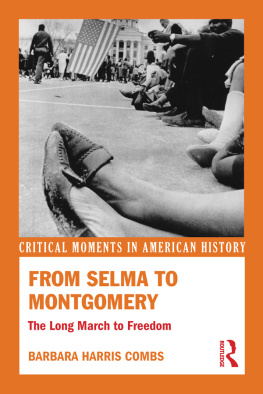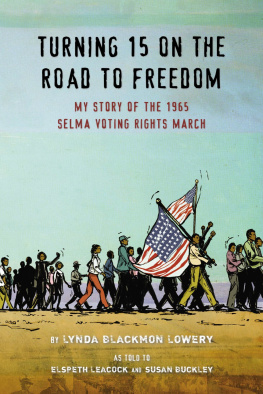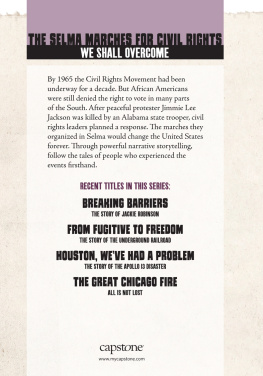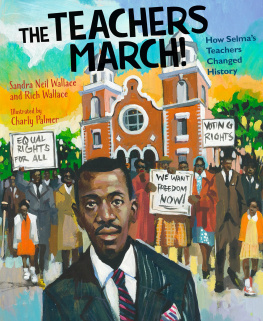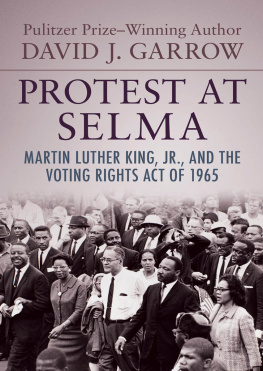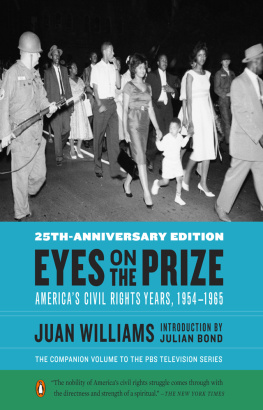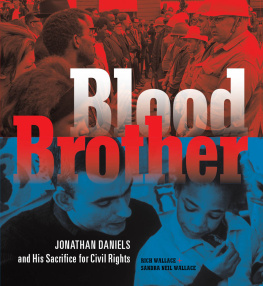SELMAS BLOODY SUNDAY
WITNESS TO HISTORY
Peter Charles Hoffer and Williamjames Hull Hoffer, Series Editors
SELMAS BLOODY SUNDAY
Protest, Voting Rights, and the Struggle for Racial Equality
ROBERT A. PRATT
UNIVERSITY OF GEORGIA, ATHENS

2017 Johns Hopkins University Press
All rights reserved. Published 2017
Printed in the United States of America on acid-free paper
9 8 7 6 5 4 3 2 1
Johns Hopkins University Press
2715 North Charles Street
Baltimore, Maryland 21218-4363
www.press.jhu.edu
Library of Congress Cataloging-in-Publication Data
Names: Pratt, Robert A., 1958 author.
Title: Selmas Bloody Sunday : protest, voting rights, and the struggle for racial equality / Robert A. Pratt.
Other titles: Witness to history (Baltimore, Md.)
Description: Baltimore : Johns Hopkins University Press, [2017] | 2017 | Series: Witness to history | Includes bibliographical references and index.
Identifiers: LCCN 2016012790| ISBN 9781421421599 (hardcover : alk. paper) | ISBN 9781421421605 (pbk. : alk. paper) | ISBN 9781421421612 (electronic) | ISBN 1421421593 (hardcover : alk. paper) | ISBN 1421421607 (pbk. : alk. paper) | ISBN 1421421615 (electronic)
Subjects: LCSH: African AmericansCivil rightsAlabamaSelmaHistory20th century. | African AmericansSuffrageSouthern StatesHistory20th century. | Civil rights movementsUnited StatesHistory20th century.
Classification: LCC F334.S4 P73 2017 | DDC 323.1196/073076145dc23 LC record available at http://lccn.loc.gov/2016012790
A catalog record for this book is available from the British Library.
Special discounts are available for bulk purchases of this book. For more information, please contact Special Sales at 410-516-6936 or .
Johns Hopkins University Press uses environmentally friendly book materials, including recycled text paper that is composed of at least 30 percent post-consumer waste, whenever possible.
My memory stammers but my soul is a witness.
James Baldwin, The Evidence of Things Not Seen
To all of the witnesses of Bloody Sunday, whose courage and determination helped to advance the cause of liberty and justice for all
And to Paul M. Gaston, my mentor and friend
CONTENTS
SELMAS BLOODY SUNDAY
Prologue
ON SUNDAY AFTERNOON, MARCH 7, 1965, roughly six hundred marchers set out from Brown Chapel A.M.E. Church in a double-file column. Leading the marchers were Hosea Williams of the Southern Christian Leadership Conference (SCLC) and John Lewis of the Student Nonviolent Coordinating Committee (SNCC). The marchers headed down Sylvan Street from the church and turned right on Water Street. As the marchers remember it, there was no singing, no shoutingjust the sound of their own heartbeats and the rhythm of marching feet. Upon reaching Broad Street they turned left and began their ascension across the towering arch referred to as the Edmund Pettus Bridge that spanned the Alabama River. The marchers were expecting resistance at some point, but to their surprise there were no police in sightonly a group of white men, gathered in front of the Selma Times-Journal newspaper building. They had hard hats on their heads and clubs in their hands. Some of them had smirks on their faces, but none said a word.
When we reached the crest of the bridge, recalls John Lewis, I stopped dead still. So did Hosea. There, facing us at the bottom of the other side, stood a sea of blue-helmeted, blue-uniformed Alabama state troopers, line after line of them, dozens of battle-ready lawmen stretched from one side of On the side of the highway was a crowd of about a hundred or so whites, some jeering and laughing and waving Confederate flags. Beyond them, watching at a safe distance, was a group of about fifty blacks. Reporters and their camera crews had been grouped together in front of a car dealership behind the troopers line, and several of the troopers were positioned near them to make sure that none of them ventured from their position.

On Bloody Sunday, March 7, 1965, hundreds of marchers tried to cross the Edmund Pettus Bridge on the highway from Selma to Montgomery, the state capital, where they planned to demonstrate on behalf of their voting rights. The marchers ran into a small army of state troopers, who brutally attacked them. John Lewis, chairman of SNCC (wearing the light trench coat), who led the march along with Hosea Williams of SCLC, suffered a beating that left him with a fractured skull. The sheer magnitude of the violence shocked the nation. Prints and Photographs Division, Library of Congress
As the marchers approached the far side of the bridge, Major John Cloud ordered them to turn back. This is an unlawful assembly, he said. Your
The brutality and horror that was about to unfold at the foot of the Edmund Pettus Bridgea day that would come to be known as Bloody Sundaywould become one of the pivotal moments of the civil rights movement and would be etched indelibly into the memories of those who witnessed and endured it. The civil rights movement had been responsible for some significant changes in the ways that white Americans viewed African Americans; for decades, perhaps centuries, whites had taken for granted black peoples acceptance of their second-class status. But by 1965, black Americans dissatisfaction with the racial status quo was becoming increasingly apparent, as too was their willingness to confront the system of rigid segregation and racial discrimination that had served as the underpinning of a society based on white supremacy. The United States Supreme Courts 1954 unanimous ruling in Brown v. Board of Education had struck at segregation in public education, and ten years later the 1964 Civil Rights Act, aimed at eliminating once and for all the remaining vestiges of racial discrimination in American life, had been passed into law by the Congress and signed by President Lyndon B. Johnson. Yet despite these judicial and legislative milestones, the most basic and fundamental right of citizenshipthe right to voteremained out of reach for the masses of African Americans residing in the states of the former Confederacy.
What follows is the story of a civil rights campaign that unfolded in Selma, Alabama, in the spring of 1965, almost one hundred years to the day that the nation ended its bloody Civil War that had been fought over black slavery. But the story of Selma is about much more than African Americans protesting for the right to vote. This is a story about the triumph of black and white protest over white resistance, the fulfillment of the promise of the Fifteenth Amendment ratified in 1870, the freedom guaranteed to all Americans by the Declaration of Independence and the U.S. Constitution, and the countless lives lost in the process of gaining that freedom. What started in Selma as a bloody conflict over who should have access to the ballot would end with a triumphant march to Montgomerythe former Cradle of the Confederacythat would begin a political transformation and realignment that would have far-reaching implications for decades to come. The election of the nations first African-American president in 2008 perhaps reflected the apex of black political power. But that election also revealed an interesting paradox: an increase in black electoral participation and a rapidly changing political landscape prompted white conservatives to resort to a new campaign of voter restrictions in order to preserve Republican Party domination. It would appear that the lessons of Selma have yet to be learned.
Next page

